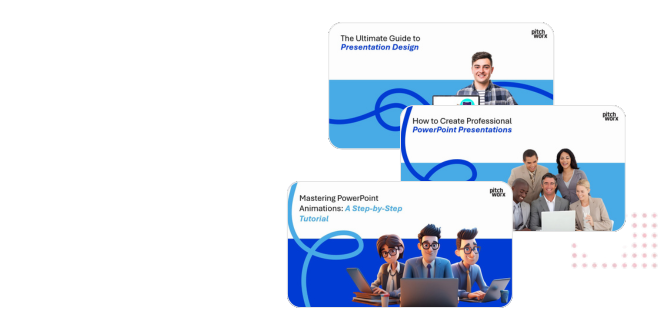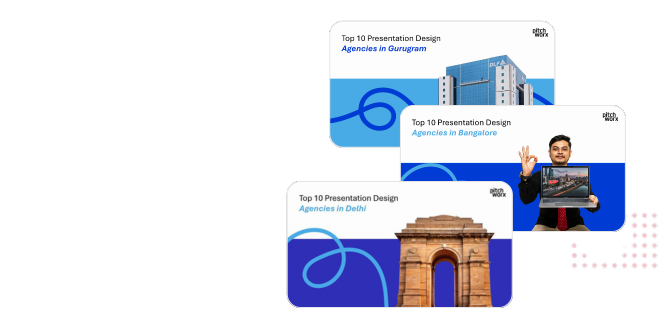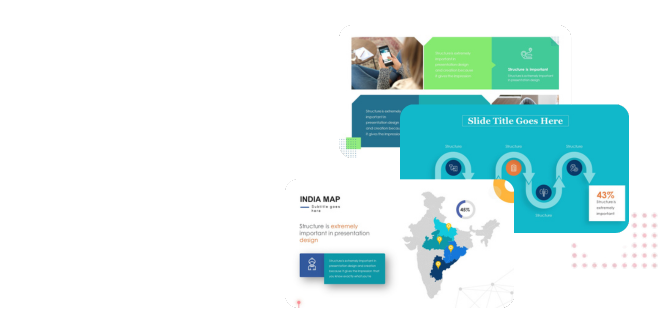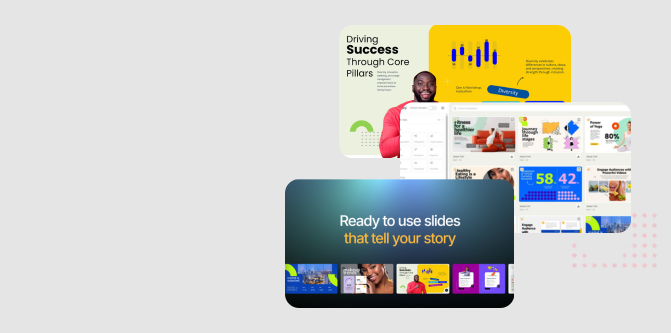
- Use AI tools to personalize content and analyze audience reactions in real time.
- Focus on visual storytelling to grab attention and keep people interested.
- Add interactive elements like live polls or real-time data visualizations to boost engagement.
- Leverage data-driven insights to tailor your presentation to specific audience needs.
Quick Tips:
- Start with a clear outline: Introduction, Problem, Solution, and Call-to-Action.
- Customize content using audience data for relevance.
- Use visuals like dynamic charts, branded slides, and infographics to make your points stick.
- Practice and use feedback tools to improve delivery and engagement.
Key Takeaway: Combine AI, storytelling, and interactivity to deliver impactful, audience-focused presentations that close deals.
Organizing and Customizing Your Sales Presentation
Developing a Clear Outline
A strong sales presentation starts with a clear and logical outline. This structure helps guide your audience smoothly through your message while keeping them engaged. Here’s a simple framework to follow:
- Introduction: Grab attention and establish trust.
- Problem Statement: Highlight key challenges your audience faces.
- Solution: Showcase how your product or service addresses these challenges.
- Call-to-Action: Clearly define the next steps.
AI tools can make this process easier. For example, you can use prompts like "Generate a sales presentation outline for [product/service]" to create a tailored structure [1]. Once you have your outline, the next step is to refine it for your specific audience.
Customizing Content for Your Audience
Personalization is key in today’s data-driven world. AI tools can help you analyze your audience’s demographics, pain points, and expertise, ensuring your presentation aligns with their needs.
To make your content hit the mark:
- Use AI to gather insights about your audience, such as their industry challenges and level of expertise.
- Highlight problems and solutions relevant to their sector.
- Adjust the level of technical detail based on who’s in the room.
For example, ProdPad connects with their audience by addressing frustrations directly. They describe how their solution turns "spreadsheets from black holes where ideas enter and rarely re-emerge" into organized systems [3]. Pairing this kind of personalized messaging with visuals can make your presentation even more effective.
Using Visuals in Storytelling
Visual elements can bring your story to life, and AI tools make it easier than ever to create them. Here are some ideas for using visuals effectively:
| Visual Element | How to Use It |
|---|---|
| Dynamic Charts | Use tools like Tableau or Power BI for real-time data visualization. |
| Infographics | Create engaging visuals with platforms like Canva‘s AI tools. |
| Branded Slides | Design professional templates with Beautiful.ai. |
Research shows that 62% of decision-makers prefer presentations backed by data [1]. By integrating visuals that align with your brand and support your key points, you can make your pitch more persuasive and memorable [2].
Mastering B2B Sales Presentations: Expert Tips & Strategies
Using AI Tools for Presentation Design
AI tools are changing the way presentations are designed, making the process faster and more tailored to specific audiences. These tools bring automation and customization to the forefront, helping teams create more engaging and impactful sales presentations.
AI for Content and Design Creation
AI-powered platforms like Magic Slides can take raw input and turn it into polished, branded slides. By analyzing the structure of your content, these tools apply ready-made layouts, generate branded templates, and even tailor messaging based on audience data. This means presentations are not only more compelling but also quicker to produce [1].
Adding Interactive and Data-Driven Elements
AI tools also make presentations more engaging with features like:
- Live data visualizations that update in real-time
- Interactive polls to gather audience feedback
- Engagement analysis that recommends changes, such as reordering slides or highlighting key data
These features are highly effective. According to DocSend, 65.4% of prospects who open a presentation deck click through to the final slide [3]. This shows how interactive and dynamic content keeps audiences engaged.
Professional Design Services
For businesses looking for expert help, professional design services are another option. Companies like PitchWorx specialize in creating presentations with custom templates, animations, and licensed imagery. They offer solutions tailored to different budgets and branding needs, ensuring a polished, professional look.
When choosing AI tools or design services, look for options that integrate with your CRM and provide real-time analytics. This makes it easier to track performance and refine your presentations over time [2].
sbb-itb-cf336c5
Tips for Delivering Your Sales Presentation
Delivering a strong sales presentation is essential for thriving in 2025’s hybrid business landscape. With advanced tools and shifting audience expectations, your approach must balance technical expertise with a personal touch.
Preparation and Research
Solid preparation is the backbone of any successful presentation. Leverage CRM insights and competitor data to shape your message and address potential objections effectively. A well-prepared presentation resonates more with your audience and leaves a lasting impression.
Here’s how to get started:
- Research your audience’s background, challenges, and competitors to craft personalized responses.
- Test all interactive features and data visualizations to ensure smooth execution.
- Practice your delivery and seek feedback using AI tools for improvement.
With your groundwork in place, focus on grabbing attention and keeping your audience engaged.
Engaging the Audience
Kick things off with a strong opening that pinpoints a key issue your audience faces. Incorporate interactive tools and storytelling to keep their attention throughout. For instance, Microsoft uses visual storytelling to showcase customer success stories, making their presentations relatable and impactful [3].
Effective ways to engage:
- Open with a hook that directly addresses your audience’s challenges.
- Use live data visualizations to adapt your content on the fly.
- Maintain steady eye contact to foster trust and connection.
Using Feedback for Improvement
Today’s tools make it easier than ever to gather and analyze feedback. AI-powered analytics can track audience engagement in real time, giving you actionable insights to refine your presentations.
| Feedback Type | Collection Method |
|---|---|
| Real-time Engagement | AI tools to monitor attention and interaction levels |
| Post-presentation Survey | Digital forms for detailed feedback |
| Sales Conversion Data | CRM systems to measure overall presentation success |
Pay attention to metrics like audience retention (currently averaging 65.4% for effective presentations [3]) and engagement during key moments. Use these insights to fine-tune your style and content for even better results.
Conclusion: Key Points and the Future of Sales Presentations
Summary of Key Strategies
To create engaging sales presentations in 2025, blending advanced technology with a personal touch is crucial. AI-powered tools have transformed how presentations are designed and delivered, making them more interactive and data-focused. Platforms like DocSend, with its impressive 65.4% prospect engagement rate [3], show how personalized, well-structured presentations can drive results.
Here are a few key components that contribute to success:
| Strategy Component | How It Helps Presentations Succeed |
|---|---|
| AI-Driven Personalization | Delivers tailored content, boosting conversion rates |
| Data Integration | Builds trust and supports informed decision-making |
| Dynamic Storytelling & Interactivity | Captures attention and encourages participation |
The Future Role of AI in Sales Communication
While these strategies are effective now, AI’s rapid development will continue to reshape how sales presentations are crafted and delivered. Companies like IBM and Salesforce are already showcasing how AI can create highly personalized proposals, allowing sales professionals to focus on building relationships while automating repetitive tasks [2] [4].
AI is revolutionizing sales presentations in several ways:
- Real-time analytics: Adjust presentations on the fly to better engage audiences [2].
- Content customization: Leverage CRM data to tailor content to specific customer needs [4].
- Predictive tools: Anticipate audience questions and provide data-backed responses [2].
These tools simplify customization and engagement tracking, enabling sales teams to deliver highly personalized, data-rich presentations with ease. While AI enhances personalization, analytics, and interactivity, the human connection remains irreplaceable. AI should be seen as a tool that complements, rather than replaces, the personal relationships that are key to successful sales presentations.
FAQs
How do you make an interactive sales presentation?
Building an interactive sales presentation in 2025 means blending cutting-edge technology with strategies that keep your audience engaged. Here are some essential elements to consider:
| Interactive Element | Purpose | Implementation Example |
|---|---|---|
| AI-Generated Content | Personalization | Real-time updates tailored to audience engagement |
| Dynamic Visuals | Visual Engagement | Animated charts, graphs, and product demos |
| Interactive Polls | Audience Participation | Live feedback during key parts of the presentation |
| Data-Driven Slides | Credibility | Integration of CRM data for up-to-date insights |
"The integration of conversational intelligence into CRM systems has transformed how we deliver interactive presentations, enabling real-time engagement and feedback previously unattainable" [2].
Microsoft serves as a great example, using "before and after" scenarios to showcase product advantages. This method connects with the audience by focusing on relatable stories [3]. Their strategy empowers presenters to:
- Show product benefits through live demonstrations.
- Adjust the presentation based on audience reactions.
- Address specific challenges as they arise.
AI tools can also analyze engagement metrics, helping you fine-tune your presentation in real time. These tools make it easier to adapt content on the fly, ensuring your audience stays engaged and your message hits the mark [2][4]. By incorporating these features, you can deliver presentations that not only capture attention but also drive results.









